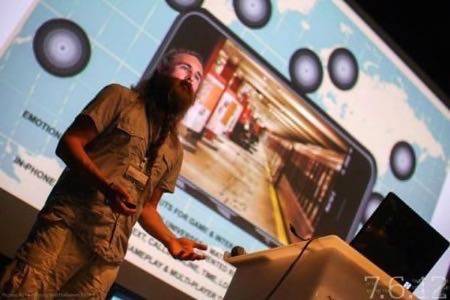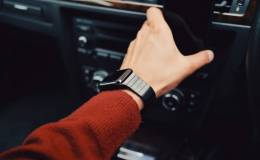Wearable World Congress is ReadWrite’s signature annual conference, taking place in San Francisco May 19-20. Every week, we’ll introduce you to interesting speakers you can meet at the event.
Today’s wearables can track all sorts of things about our physical condition. Some even track our brain waves. But emotional states may be the last frontier. For years, companies small and large have attempted to quantify feelings, but new sensor technology has powered a new crop of players—like Sensum.
Its CEO and founder, Gawain Morrison, started off as a film producer, but then jumped into wearables with Unsound, a emotional response horror film that premiered at SXSW in 2011. The creative project hooked up nine audience members with finger sensors to monitor pulse and other physiological responses, which then directed the action they would experience. Think of it like a choose-your-own-adventure story, but guided by the body’s response to action or scary scenes.
Buy tickets now for Wearable World Congress, May 19-20
The experiment led to new wearables feedback software made by Sensum and Morrison, who will speak at Wearable World Congress about his mood-tracking technology. I spoke with Gawain in advance, to get his take on the importance of quantified emotions.
What was your first experience with wearables like?
My first experience was actually for Unsound, our emotional response horror film. It was a wearable in that we were asking people to wear straps to collect biometric data, but it wasn’t mobile.
We used the heart rate and the skin conductance of the audience to control the score, the sound effects, the scene selections and the endings. It meant that every audience had a unique cinematic experience based on how they emotionally responded. We even had a sub-sonic frequency that would make people’s skin crawl if they weren’t scared enough. It was a whole lot of fun.
Things have changed an incredible amount since then. They’ve gone mobile. People are starting to find different use models for them, more specific to the kind of data they can capture. We’re beginning to move beyond hardware that can capture data, into the value of contextualizing the data to provide insights.
Are there any other wearables that impress you?
My favorite marriage of hardware, data and insights is Urska Srsen’s Bellabeat. It’s a perfect model of understanding a market, understanding the problems and taking the same kind of electronics that everyone else has to work with, and making it ergonomically and aesthetically fit for purpose, offering real value to pregnant women.

Recently, your focus has been on connecting wearables to physiology (EEG, GSR). What’s the immediate opportunity there for businesses and for consumers?
Every person is unique, yet we have social structures, economic structures, entertainment and retail structures, These are largely built for a group approach to our worlds. If we augment those systems to allow for degrees of personalization that benefits the individual, [it would] open up different kinds of relationships with the institutions that we work for, play with or are bound by. Then there could be less stress and better engagement.
See also: BellaBeat’s Urska Srsen Designs Health Trackers For Women From The Inside Out
Measuring biometrics could allow you to ‘visualize’ these responses to provide insights to these kind of things.
This has obvious personal benefits, but it can have massive business effects by having a happier and healthier workforce. The only issue for business is whether they should make it a policy or a recommendation. Is it right to force your employees to do this? Or is it enough to have advocates show off what it can do, and for the majority follow suit because it will genuinely make them feel better?
As for consumers, wearables will only continue to get smaller, with better battery life and more sensors picking up data from your person, as well as contextual data from the world around you. There will be a phenomenal amount of “personal data” that really needs to have a home that is yours—your digital self in your digital space, representing the real-world you. It’s the digital presentation of you, and as such should be respected in the same way.
What is the community learning about the influence of wearables on human behavior? How are wearables shaping us?
The large and chunky, self-identifying early-adopter versions of almost all wearables have largely been due to spin-outs—garage-engineers and indie designers chasing their dreams, and not having big budgets to throw at R&D. The early adopters, largely in health and fitness, are happy to be wired up and have something chunky while running or cycling. Or to have a smartphone strapped to their body.
But these aren’t scale solutions as yet. That’s clearly apparent by the slower than expected sales uplift in the wearables sector—which everyone is expecting the Apple Watch to change.
The other side that has potentially slowed things, but is also a human behavior change, is the more something can identify you or covertly identify the world/society around you, the more there is likely to be a backlash, mostly due to our collective paranoia around surveillance. We cannot change overnight what we’ve come to believe—trust and distrust in our ‘real’ world. These behaviors and beliefs carry into our ‘digital’ world.
We’re happy to embrace a technology if it can genuinely help or offer things in ways never before experienced. Get enough “useful” wearables on the market for a range of “real” world reasons, and all human behaviors will change. And quickly.
To hear more from Gawain Morrison and other innovators and experts, register for Wearable World Congress 2015, May 19-20 in San Francisco.
Photos courtesy of Gawain Morrison









